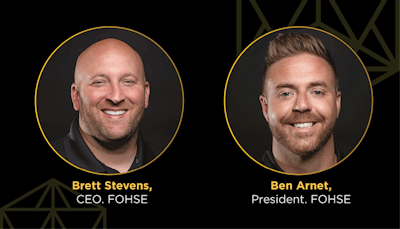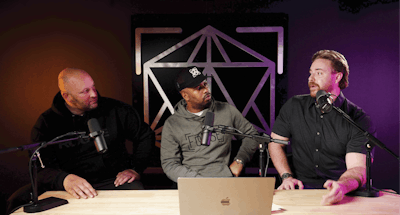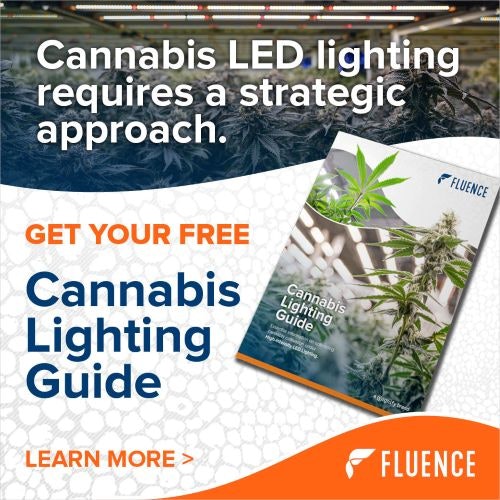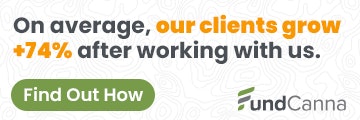In 2015, FOHSE set out to build an LED grow light that would not only match—but also surpass—the capabilities of any lighting system ever seen in cannabis grows. In this first episode of the “Welcome to the Future” podcast series, produced by FOHSE, Leonard Wilson, chief marketing officer at the Las Vegas-based company, sat down with co-founders Brett Stevens, CEO, and Ben Arnet, president, who shared the origin story of the company. Stevens and Arnet discuss the founding days of FOHSE, what drives their business decisions and the benefits of being headquartered in the Las Vegas market.
Leonard Wilson: What is FOHSE? Where did FOHSE come from? What is it, for the people that don’t know?
Brett Stevens: FOHSE is an acronym for “Future of Horticulture Science & Engineering.” It was derived from the word “phos,” which means “light” in Greek. Originally the company was going to be called “phos,” as in “photosynthesis.” But there [were] some trademark issues, so we had to look for a new way to spell “phos.” So, we spelled it FOHSE and gave it an acronym.

LW: What about you, Ben? What was your contribution with starting FOHSE and piggybacking on what he said?
Ben Arnet: Yes, so like what Brett said, one of the biggest things that everyone in the founding team had was just an entrepreneurial spirit. We didn’t fester on any bad news or any negativity too long. We immediately would pivot, like “phos” to FOHSE. It was actually Brett and I raising capital in Las Vegas and on the West Coast for cannabis cultivations, real estate and a couple other things. A friend of mine from high school who was a robotics laser engineer reached out to [me] and Brett and said, “Hey, check out this LED light. I think it could change the game.” It was high power. It had a full spectrum. It was stuff we had not seen on the market before. We said, “This looks pretty interesting. Let’s build a couple prototypes and see what happens.” So, we flew him out, flew all the components out. Brett and I actually owned a motocross shop at the time, and we spent a whole weekend hand-building four [LED] prototypes. After that, we brought them to a couple different cultivations we had some ins at. And 60 days later, a couple of [the cultivators] called us up and said, “You guys need to see this.” And there were plants growing sideways into our lights, away from other lights, and at that point the lightbulb clicked, pun intended. And that’s when we really dug into FOHSE, light science, and tried to just sponge up everything we could and really start innovating our first product, which was our A3i. Then the rest of the catalogue: F1V, O6i, Pleiades, Cobra, Aries, Scorpio. I mean, if there was a light [cultivators] needed, we made it.
LW: How important is having a quality LED light for growers and cultivators within this industry?
BS: It’s pivotal, right? I think that having something that’s high quality is, one, very important for the reliability of the crop, knowing what you are going to have. Especially if you are selling into futures, or if you’re trying to look at where the company is going to be and what the yields are going to be. So, making sure that you are not losing light is kind of pivotal to that. Then also quality, right? Making sure that you’re buying a light that is not only producing the most grams per square foot, but [producing the most cannabis] that you can in the [entire] facility because again, that’s bottom line. Also, you want something that’s going to increase the quality as well, whether that being overall terpenes or THC, whatever it is. Having high-quality light will help you increase both those.
LW: What does the average person say to you guys when they come to you looking for a better product? How do people approach you usually? What does that conversation start like?
BA: People, when they first hear about FOHSE, it’s either, one, they knew us from a friend that’s using our products, or, two, they saw some of our marketing and said, “I’ve never seen a light output that high. You got my curiosity.” Because if you look at basic spec sheets, the A3i puts out 4,200 PPF. The next closest competitor is about half that. So, you’ve got to imagine all growers are going to go, “Why would they make a light so powerful?” And then you start to see what the plants are doing underneath it. You talk about ramping, how we started 50%, go up a percent a day. Switch spectrums to help reduce shock and stress in early stages that first month the plant pops into flower. What that does over the entire crop cycle or at harvest, it means higher terpenes, cannabinoids, better yields, better canopy penetration, putting the right stress on the plant. There’s a lot of things that come with it. So, one, it’s a curiosity thing, and two, if they see what the light has done, they usually say, “Yeah, I saw the A3i. I want that,” and they know what they want, or they say, “What would you guys recommend? I see you guys put out some high-powered stuff. No one else is doing that. Why did you do it, how did you do it, and what’s the benefit?”
LW: What’s the largest misconception that you both have come across as it relates to people saying, “Oh no, we don’t need that right now. We’re good with this light that we have?”
BS: “High PPFD means low quality.” That’s the farthest thing from the truth. Genetics are going to express the way genetics do, and as long as you’re keeping up with feed, and as long as you are keeping up with removing the moisture from the air, you’re going to have monster plants that are beautiful and full of THC.
LW: Ladies and gentlemen, essentially what he’s saying is, “Yes, the lights are important, but there are so many other variables that have to be in play as it relates to having a successful room. Removing the moisture from the room, and a few other variables like that.” So, what would you say is a misconception that you’ve noticed?
BA: Yeah, that’s one of the big ones that we’ve just noticed recently is that people miscommunicate high PPFD to low quality, which Brett kind of nailed. This is when feedings are only at 2.0 EC, or they didn’t know how to use high-intensity lights but it’s very easily compatible. Once you start looking and talk to a couple cultivators who are using 1,500 PPFD and you see their COAs, you see the yields and they’re not, one, just achieving higher quality, they’re achieving higher yields and they’re doing it faster. That’s because [with] the photosynthetic rates in the plants, with more light energy, there’s more photosynthesis going on. Those chemical reactions are happening more and faster. So, when that happens, you can’t say there’s going to be less quality oil from a higher-energetic plant. That just doesn’t make any sense.

LW: What has been a deciding factor in scaling the company as you guys have done in the last seven years? What has been one of the leading decisions in growing it?
BS: Making sure we don’t grow too fast. We want to make sure, first and foremost, integrity is number one at FOHSE. So we’re never just going to send lights and just say, “Good luck.” We want to be here with cultivators as they’re growing. We want to make sure if there’s anything we can do to make sure they’re successful, whether it be with helping with genetics, whether it be helping with any SOPs. Whatever needs to happen in that grow to make sure that their success is going on, is what we need to do. Because in the end, their success is our success. And so, we really pride ourselves in growing slow as a company as far as making sure we are taking on clients that we can provide value to and that won’t just be washed down the proverbial sink, as we continue to grow and grow and grow.
BA: We call it rolling the red carpet out. We’re not just a lighting manufacturer. First and foremost, we are an engineering firm. Everything you see designed in-house, we are the manufacturer, the OEM [original equipment manufacturer]. If you want to test, we encourage it. And just let the plants be the judge. The plants will always tell the truth. But with that was bringing on people with expertise that we didn’t have. So, our horticultural team, completely brought on by us from guys who have used our technology in commercial settings. Greenhouses, vertical grows, single tier, grown against HPS, other LEDs and other guys who have basically collected all the data on how they were so successful without units. We brought those guys on and made them our in-house horticulture team. They will go out and spend days if not weeks with clients, depending on how fast they need to learn how to use the system or if there’s any issues that they do have. They will mitigate problems, write SOPs, and they’ll kind of hold their hand through that first harvest. That’s been a huge one for us because maybe 90% of our guys knock it out of the park [the] first time they set up the lights. But for those 10%, we don’t want that 10% to fall behind if we can help even 10% or 1%. It’s a win for us. And like Brett said, their success is ours. And we don’t want anyone to have a bad story with us. Our integrity is everything, so really kind of going above and beyond. Whether it be engineers or horticulturists, plant physiologists, we got your back.
Because in the end, their success is our success. And so, we really pride ourselves in growing slow as a company as far as making sure we are taking on clients that we can provide value to and that won’t just be washed down the proverbial sink.
LW: How do you guys continue to stay on the leading edge with new lights?
BA: We’ve built lights for propagation, veg, mothers, early flower. We’ve tested spectrums for every clone, tissue cuts. We’ve made lights for everything. It’s providing value, whether it be our technology, our team, our knowledge. That’s what we really strive for is educating the masses.
LW: Did you guys ever see Vegas turning into the market it is now? What were some of those signs that you knew?
BS: We both moved from the Midwest here for the cannabis industry, so we knew we wanted to be a part of this market. We didn’t know the regulations were going to be as good as they are here. For anybody that doesn’t know, the regulations here are pretty strict, and it’s a great environment to grow cannabis in this state. Probably one of the best I think maybe in the whole country, so as far as the fewer cultivators, the testing is really, really strict. That’s how originally we got into this, right? We were both working at a grow and then came from the plant side over here. I mean, it just so happened that we’re in a desert, and we could see more quickly than I guess anybody else the need for LED, so we’re really in a unique position to where we knew engineers, we knew there was a need, we knew the market and we knew what the climate was like here. We didn’t want to run night cycles, we didn’t want to compete against the nightlife business here, as far as having manpower, [and] we needed something to where we weren’t freezing our ACs up in the summer.
LW: What about you, Ben? Were you all on board with Vegas?
BA: Yeah, like Brett said, we didn’t know how well it was going to roll out. We just knew that this was going to be an awesome market based on all the research we did on Colorado and California. We saw this as the destination spot when you saw how many millions of people come here, you’re like, “This market is solid.” You know everyone’s going to overpay, so it seemed like a phenomenal market, and then we saw the bonuses of limited license and making sure that all the cultivators came with awesome business plans. I mean they had to go through so much just to get that license. But because of the price of cannabis, the price per pound of the cultivators, the cultivators are making money in Nevada. You’re getting still $2,000 to $3,000 a pound for flower here in Nevada, so if you can grow, this is a great market for sure.
Editor’s Note: This conversation has been edited for length and clarity.

